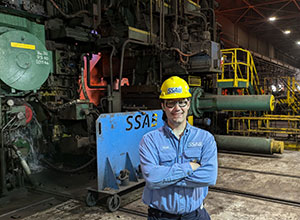2024 Steel Intern Scholarships
 Ryan T. McGinnis
Ryan T. McGinnis
This summer I had the great privilege of working at SSAB Iowa Inc. in Montpelier, Iowa, USA, as the technical services intern. In this role, I worked with the technical services team with three outstanding rolling mill metallurgists to ensure plate and coil quality while improving rolling processes. This internship was highly rewarding, as I got opportunities for both technical and professional growth in the industry.
My duties started with the processing of quality test reports from mill operators. This included gauge profile reports, ultrasonic testing reports, and flatness checks to ensure products met our standards. This work impressed upon me the necessity for thorough reporting of quality metrics and taught me the intricacies of quality testing. While not one of my responsibilities, I think it is prudent to mention the opportunities I had to attend team meetings and audits. With these, I got to learn about mill safety and our quality management system — both are imperative to the success of the mill.
 The metallurgy team quickly taught me the necessary laboratory skills to perform macro-slab etches and micro-cleanliness checks safely. I swiftly set to work preparing etches and analyzing the results. The scale of the slab samples was unlike anything I had ever worked with before. Once etched, I would create a report to disseminate my findings to mill engineers and leadership for further analysis. With the micro-cleanliness samples, I cut, mounted and polished coil samples for the team to inspect for detrimental inclusions (oxides and stringers). With these responsibilities, I got to practice my metallography preparation skills and learn how to identify and prevent defects in steel. Throughout this process, I furthered my understanding of solidification with real-world centerline segregation examination and developed an understanding of continuous cast steel quality.
The metallurgy team quickly taught me the necessary laboratory skills to perform macro-slab etches and micro-cleanliness checks safely. I swiftly set to work preparing etches and analyzing the results. The scale of the slab samples was unlike anything I had ever worked with before. Once etched, I would create a report to disseminate my findings to mill engineers and leadership for further analysis. With the micro-cleanliness samples, I cut, mounted and polished coil samples for the team to inspect for detrimental inclusions (oxides and stringers). With these responsibilities, I got to practice my metallography preparation skills and learn how to identify and prevent defects in steel. Throughout this process, I furthered my understanding of solidification with real-world centerline segregation examination and developed an understanding of continuous cast steel quality.
In addition to my normal responsibilities, I also led a project to investigate the rolling practices of a high-strength low alloy (HSLA) weathering steel. For this project, I selected samples from rolled material to explore the relationship between toughness and rolling temperatures. This work led to an affirmation of two temperature-toughness relationships and additions to a database for optical micrographs.
I want to thank SSAB Iowa and the technical services team for this outstanding opportunity and their consistent support. Additionally, I would like to thank AIST for their work facilitating this experience and their support of my education.
